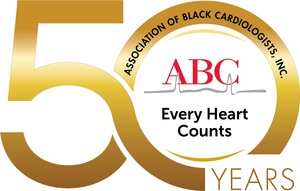WASHINGTON, Jan. 4, 2023 /PRNewswire/ -- As the highly disturbing images of Buffalo Bills safety Damar Hamlin collapsing from a sudden cardiac arrest (SCA) during a nationally televised football game are viewed and reviewed worldwide, the Association of Black Cardiologists (ABC) extends its sincere prayers and wishes to his family, friends, teammates, and fans for a prompt and complete recovery. At a time like this, so many are left wondering, "how could this happen to such a young, physically fit professional athlete?"
Based upon the information available at this time, it appears most likely that Mr. Hamlin suffered from a special case of cardiac arrest brought upon by blunt trauma to the chest, known medically as commotio cordis. The energy transferred from a focal, high-velocity impact to the chest wall by an object such as a baseball, hockey puck, football helmet or even a fist or foot can, when occurring a at precise moment during the heartbeat [called the vulnerable period], lead to ventricular fibrillation - a chaotic, disorganized cardiac rhythm that results in cessation of effective pump function and loss of pulse. This rhythm leads to sudden cardiac death, unless immediately reversed, typically as in this case, by application of an electric shock from a defibrillator. While commotio cordis is a strong consideration for the cause of Mr. Hamlin's arrest, many other underlying conditions must be assessed in sports-related cardiac arrest, including inheritable diseases of the heart muscle itself, or of the proteins imbedded in its cell membranes which govern the heart's electrical signals. The chances of recovery drop 10% for every minute spent in ventricular fibrillation. Mr. Hamlin is unusually fortunate to have benefited from prompt and appropriate action from highly skilled medical personnel, which is not typically the case when a similar incident occurs in a lower profile setting.
The Association of Black Cardiologists strongly endorses exercise as a key pillar to living long and healthy lives. However, as we have seen, participation, particularly in competitive, contact sports is not without its cardiovascular risks. Fortunately, such events are relatively rare and range in incidents from 1 in 40,000 to 1 in 80,000, depending on a variety of factors such as type of sport and age of the athlete.
As we wait to learn of Mr. Hamlin's course, we hope that this sad and terrifying event leads to increased awareness of these risks, and the systemic steps that can be taken to minimize them such as provision of appropriate equipment and trained personnel at sporting events, and to a renewed appreciation of the importance of bystander CPR and automatic external defibrillator training in all communities.
G. Mark Jenkins, MD, Co-Chair, ABC Advisory Group and Former ABC Board Member; Kevin F. Kwaku, MD, PhD, Co-Chair, ABC Electrophysiology Committee; Camille G. Frazier-Mills, MD, MHS, Co-Chair, ABC Electrophysiology Committee; Richard Allen Williams, MD, Founder of ABC; Jayne Morgan, MD, Co-Chair, ABC Communications Committee; Marlon E. Everett, MD, Co-Chair, ABC Communications Committee; Anekwe E. Onwuanyi, MD, President of ABC, and Barbara A. Hutchinson, MD, PhD, Board Chair of ABC.
Founded in 1974, the ABC is a nonprofit organization dedicated to eliminating the disparities related to cardiovascular disease and achieving health equity such that all people can live long healthy lives. Membership is open to all interested in the care of people with or at risk for cardiovascular disease, including health professionals, lay members of the community (Community Health Advocates), corporate and institutional members. Today, the ABC's public and private partnerships continue to increase its impact in communities across the nation. For more information, visit www.abcardio.org and wearethefaces.abcardio.org or connect with ABC on Twitter, Facebook, Instagram, and LinkedIn.
SOURCE Association of Black Cardiologists

WANT YOUR COMPANY'S NEWS FEATURED ON PRNEWSWIRE.COM?
Newsrooms &
Influencers
Digital Media
Outlets
Journalists
Opted In






Share this article